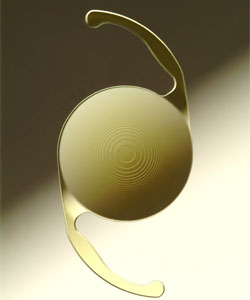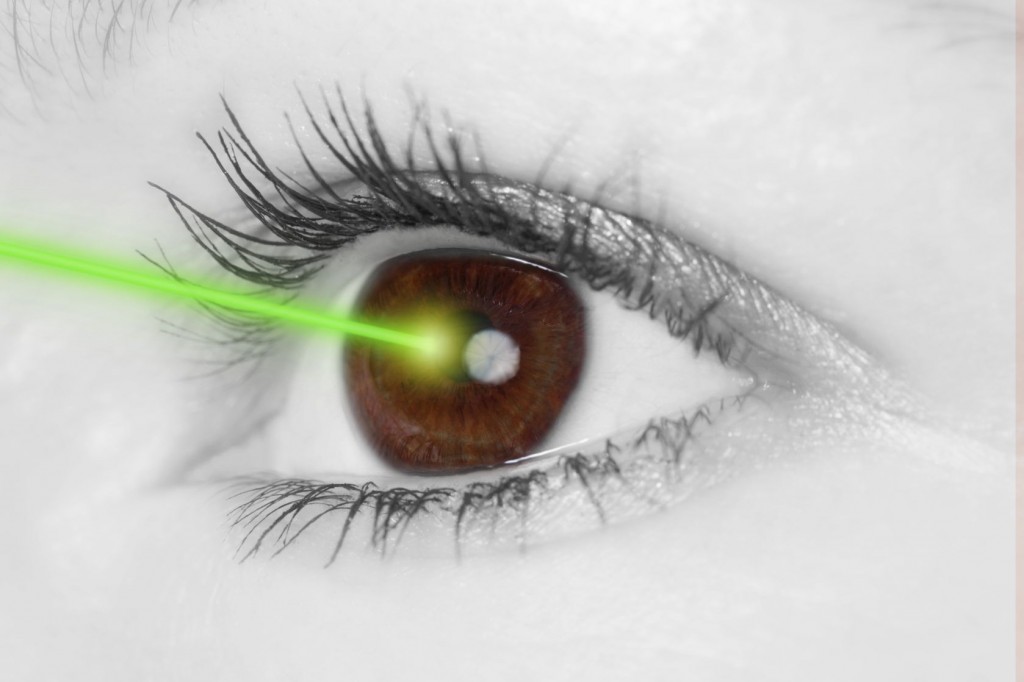The ReSTOR Lens Implant
The ReSTOR lens implant is one of the types of multifoal intraocular lenses (IOLs) used for eye lens replacement after cataract surgery that gives more than one area of vision in focus to increase your freedom from glasses.
I met one of its inventors in Seattle last year while speaking at a conference and it was interesting to hear him talk about all the effort and science behind the ReSTOR lens.

How does the ReSTOR Lens Implant work?
The ReSTOR lens implant contains a series of rings that focus light. Some of the rings focus for distance and others for nearer vision. The height of the rings near the center are taller than those further out. This is called apodization.
In bright light, the ReSTOR lens implant gives both distance and near vision. In dim light, the lens focuses most of the light for the distance image. This cleaver engineering decreases the amount of nighttime glare and halos making this a better multifocal intraocular lens for night driving.
Apodization makes it easier to see and walk around in dim light, but on the other side, it would be harder to read in dim light.
Ideal Candidate for the ReSTOR Cataract Lens?
I recommended the ReSTOR multifocal intraocular lenses for my father when he flew up for his cataract removal procedure. He is in his 70’s, spends time on the computer, jogs, and still refs high school basketball and volleyball games.
With his lifestyle, he and everyone he refs for wanted him to have good distance vision. In addition, he wanted to be able to see the scorecards and felt it would be better to do all of this without the hassles of glasses. After considering his lifestyle and specific visual needs, we both felt the ReSTOR cataract lens would be the best of the multifocal intraocualr lenses for him.
He can both ref his games and fill out the scorecards without glasses. He does notice some halos at night that don’t affect his driving.
Most ReSTOR lens patients (80%) don’t need glasses for anything.
My father sees very well without glasses, but has elected to get a thin pair that he uses when he wants to make his good vision great. He loves his ReSTOR lens and says his eyes, “are the part of my body that works the best now.”
Ideal ReSTOR lens candidates want good vision, but don’t need perfect vision to be satisfied. They place a high value on freedom from glasses. They have otherwise healthy eyes and don’t drive at night for a living. If this sounds like you, then the ReSTOR lens may be the best eye replacement lens for you.
Side Effects of the ReSTOR Lenses
Multifocal intraocular lens implants give more freedom from glasses with some increase in night halos and a slight decrease in contrast for distance vision Some see a shadow around letters when they read.
If you have very dry eyes, retinal trouble, or corneal problems then a multifocal intraocular lens may not be the right choice for you. In addition, those that require optical perfection or who are long-haul nighttime truck divers usually are better served with single vision lens implants.

What are ReSTOR Lens Problems?
In the FDA trial, 94% of patients with the ReSTOR lens implant were happy with their lenses and stated that they would choose the same lens all over again if they where given the chance. This is a very high rate of satisfaction for a medical procedure. This section is written for the other 6% that were not has happy with their lens choice. In the FDA trials, we were not able to do other surgeries to make these patients happier until after the study concluded.
I have loved the ReSTOR lens have placed it in many of my patients over the years but it is not perfect. Prior to surgery I tell my patients that we do not have a perfect implant. It doesn’t exist in the world, but what we do have is pretty spectacular. All of the implants have pluses, minuses, and quirks. The goal is to find the IOL that is strong in the areas that matter most to you and weak in areas that aren’t that important to you.
Success with the ReSTOR lens requires that we get very close to the refractive target. The biggest ReSTOR lens problem is to end up a bit near or farsighted or have some uncorrected astigmatism. This would cause blurry vision for both far and near vision. The near vision is more sensitive to this.
When this happens we can either use glasses, contact lenses, laser eye surgery, limbal relaxing incision, or exchange the IOL to solve this ReSTOR lens problem.
Dry eye causes blurry vision. When we read, we don’t blink as many times per minute because we don’t want to loose our place. This makes dry eye and blurry vision even worse when we read. The multifocal intraocular lens is particularly sensitive to this. If you are having trouble reading after ReSTOR lens placement, then you may need to treat your dry eye more aggressively.
About 20% of all cataract surgery patients develop a cloudy capsule (PCO) behind their intraocular lens regardless of they type of IOL they have chosen. This causes blurry vision and glare. This is corrected by polishing an opening in the capsule with a yag laser.
Treating residual refractive error, PCO, and dry eye will solve most of the ReSTOR Lens problems. A small percentage of patients do not like multifocal intraocular lenses and they have to be removed.

Types of ReSTOR lenses
The ReSTOR lens implant is the only U.S. multifocal intraocular lens that offers both UV protection and high energy blue protection which protect the retina and decrease night glare. The ReSTOR 4.0 gives distance vision and close, strong near vision. The ReSTOR 3.0 is preferred by more patients as it gives distance and good near with pretty good intermediate vision.
The ReSTOR 2.5 which gives distance and good intermediate for say the computer and a nook, but most need readers to read a paper book. I was in the first to implant the ReSTOR 4.0 in Colorado and was involved in the FDA trials for the ReSTOR 3.0 and 2.5 so I have used these lenses for a long time.
New IOLs
Several new IOLs have been introduced into the U.S. that offer some compelling features.
The Vivity IOL is a lens designed to give great distance and intermediate vision but specifically designed to avoid night haloing. I was involved as a principle investigator in the Vivity FDA trial where we noticed no more night haloing with that lens than a basic monofocal lens. We have never seen that before.
The PanOptix lens is the first trifocal IOL in the U.S. and the most popular trifocal IOL in the world. By trifocal I mean that it is specifically built to deliver far, intermediate, and reading. It does have some night haloing. In its FDA trial, 99.2% of patients said, if given the chance to go back, they would still choose the same lens again. This is the highest self declared level of patient satisfaction we have ever heard from a presbyopia correcting IOL.
With the advent of these two new lenses I still use the ReSTOR lenses for some patients, but the majority are choosing one of the two new advanced technology options. Isn’t it great to live in a time of constant innovation?
How do I choose an Experienced Advanced Technology IOL Surgeon?
The multifocal lenses are more exacting than standard lens implants so find a great ReSTOR surgeon is important. Start by asking your eye doctor who in the region is a great ReSTOR surgeon. You can call ophthalmology offices in the area and ask if any of their surgeons do a lot of ReSTOR lenses. The answer to these questions will help you narrow the search down right from the start. In some circumstances you will need to travel to find the right one. We have an executive/celebrity cataract program to make it more time convenient for those traveling from distances or requiring greater discretion.
It is ideal if your surgeon uses a laser to help with the surgery and the ORA system for greater accuracy. Using these technologies demonstrates a commitment to excellence. In addition, it is helpful if your surgeon also performs laser vision correction in case any touch ups are needed to refine your vision without glasses.
Finally, there needs to be a good fit personality wise with your doctor. There are some doctors that are great surgeons, but not very personable while others are very friendly, but lack the expertise or hand skills that you would consider important. When it comes to your eyes and your healing, it is reasonable to insist that your surgeon has both.
ReSTOR Cataract Lens
The ReSTOR cataract lens has a long track record. The apodized diffractive pattern minimizes the night halo issues and the yellow chromophore decreases night glare and minimizes high energy sunlight damage to the retina. In many ways it is a triumph of modern innovation, and yet it is not perfect, as we have discussed above.
If I can help answer any other ReSTOR lens questions for you, please schedule an appointment to visit with me or post a comment.
